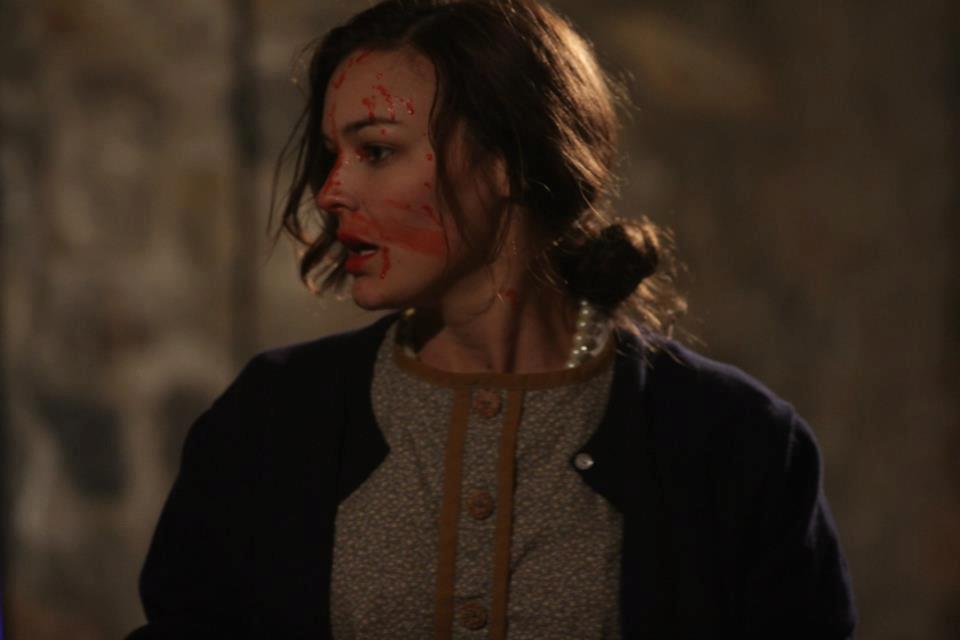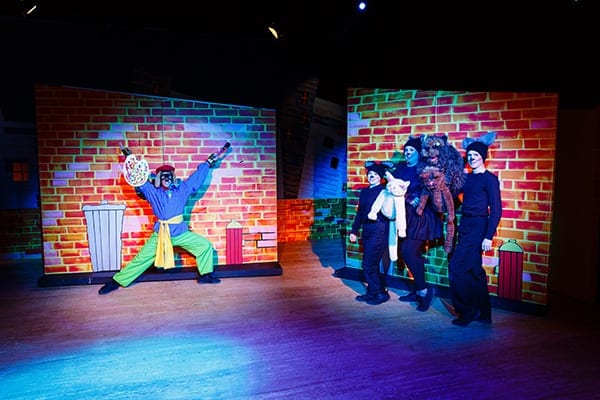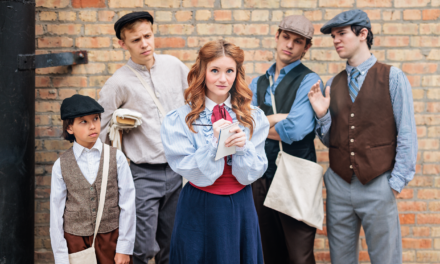
Show closes November 3, 2012.
PROVO — I didn’t notice the cold for 45 minutes on Friday night.
And it was definitely cold. It was probably around 35° up at the Castle Amphitheater that night, despite a fire burning in the hearth of the Castle’s turret room. For the 45 minutes of Warboy Theatre Project’s The Tell-Tale Heart, though, I didn’t notice anything besides the action happening in that room.
Let me back up. Warboy’s The Tell-Tale Heart is an adaptation of the classic short story of the same name by Edgar Allan Poe, but don’t think this is Poe’s story. It isn’t. This adaptation, by Brian Grob and Elena Yazykova and directed by Jyllian Unice, takes place in a 1940’s mental hospital. (How appropriate to perform the tale in a space only feet from Provo’s own Utah State Hospital.) The story unfolds around three patients—Heather, John, and Ray—under the care of an even-tempered doctor and apprehensive orderly. The plot doesn’t follow the familiar Poe story, but rather explores a situation of similar desperation and insanity.
I arrived a few minutes before the show was set to start, but as soon as I opened the door I found action already happening inside the drafty tower room. Melanie Thomason, Phil Varney, and Brian Grob—as Heather, Ray, and John, respectively—brought the Tell-Tale world to life sooner than many of the audience members anticipated. I expect it began long before any of us received our entrance wristbands (in the place of tickets) that were oddly reminiscent of hospital bracelets. It was at the moment when I entered the room that I realized Warboy’s show wasn’t going to be a typical Utah Valley theatrical experience.
Rounding out the cast was Leviticus Brown as the orderly and Jason Sullivan as the doctor, and they were indeed a well-rounded cast. There wasn’t a moment of weakness or inconsistency from anyone. As I noted in the beginning of this review, it was freezing in that room. I couldn’t believe the composure the actors maintained throughout the show; not one showed signs of chill. My teeth would have been chattering louder than a bass drum had I been onstage without a thick coat or layers and layers of costume. (Luckily, Warboy provided a few blankets for unprepared audience members so chattering teeth didn’t disturb the action.)
Thomason as Heather and Varney as Ray had the most stage time and created some incredibly intense and terrifying moments. I loved how Thomason seemed so cool and collected in the first few minutes of the show but soon revealed herself to be experiencing an excruciating mental and emotional struggle. Varney had some of the most mesmerizing interactions onstage. His character was mute and barely made a sound through most of the show; the audience didn’t know much about him beyond his silence, but his character was the one I became the most attached to. I wondered about his welfare and what he was thinking. One of my favorite moments came when Ray was left alone in the room after a particularly heated exchange between other characters. It was so quiet during the many minutes he was left alone, yet there was obviously a great deal on his mind. His hesitant, fearful actions revealed the brutal conditions the patients lived in and caused me to wonder, again, what had happened to this boy.
 Much of the show’s exposition remained a mystery, but I think that was intentional. There isn’t a lot of character backstory or clarification of the circumstances or setting. This made for some captivating moments through most of the show, but did leave me rather confused sometimes (most notably in the last few moments of the play). The imagery left what was actually happening fairly unclear: did Heather actually go through with what she wanted? What was in the bags? Did the orderly know what Heather did? Did the heartbeat give her away?
Much of the show’s exposition remained a mystery, but I think that was intentional. There isn’t a lot of character backstory or clarification of the circumstances or setting. This made for some captivating moments through most of the show, but did leave me rather confused sometimes (most notably in the last few moments of the play). The imagery left what was actually happening fairly unclear: did Heather actually go through with what she wanted? What was in the bags? Did the orderly know what Heather did? Did the heartbeat give her away?
The Castle Amphitheater in Provo has spaces full of potential, and the tower room is one of my favorite. It’s a simple room with stone walls, a dirt floor, a fireplace, three doors, and windows covered with bars and shutters. Like I said: full of potential. Warboy—and specifically set designer Dan Whiting and lighting designer Michael Gray—used the room’s existing elements to create an altogether real environment for their characters. I could completely imagine forgotten, hopeless patients crowded into that dirty, freezing room lit by three exposed light bulbs.
The only action the audience saw was whatever happened within those four walls, even though action continued far beyond them. If the windows or the perfectly creaky door were left open, the audience saw the orderly walking around or patients being taken to receive treatment, but if the windows were shut we merely heard screams, footsteps, and unrecognizable—and often ominous—sounds. Even the cold itself added to the atmosphere of the space, though I was still very grateful for the fire burning in the hearth. The sound was a huge part of the play’s action, as one might expect from a telling of The Tell-Tale Heart. Todd Mitchell’s sound design heightened the action of many moments. He deftly used extremes of booming drums and deathly silence to allow the audience to experience a sliver of the characters’ insanity.
This isn’t a show for young children. Warboy recommends only audience members aged 13 and up attend, and I second that. With startling moments and some gore, this is the perfect Halloween show for mature audiences. This production leaned more on the side of experimental when it comes to Utah Valley standards, but was by no means abstract. The show’s real weakness came from the few ambiguous plot points (like the ending) and structural tendencies. At the beginning, for example, the play set us up to think that Heather was a nurse or caretaker at the hospital, but a plot twist forces the audience to rethink this premise. This sort of twist seemed to set the structure of the show up for more twists or surprises to come later on—and perhaps even a huge surprise at the end—but there weren’t any other major twists. That left me with a hint of disappointment at the show’s close, but no more than a hint. I was entirely pleased with the show as a whole, the performances of those involved, and the masterful efforts of the production team.






